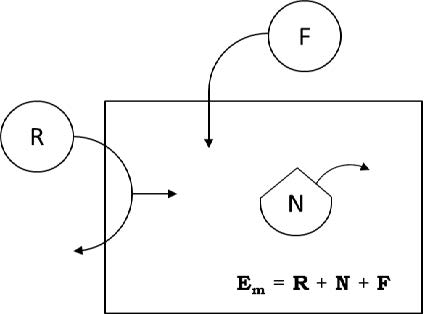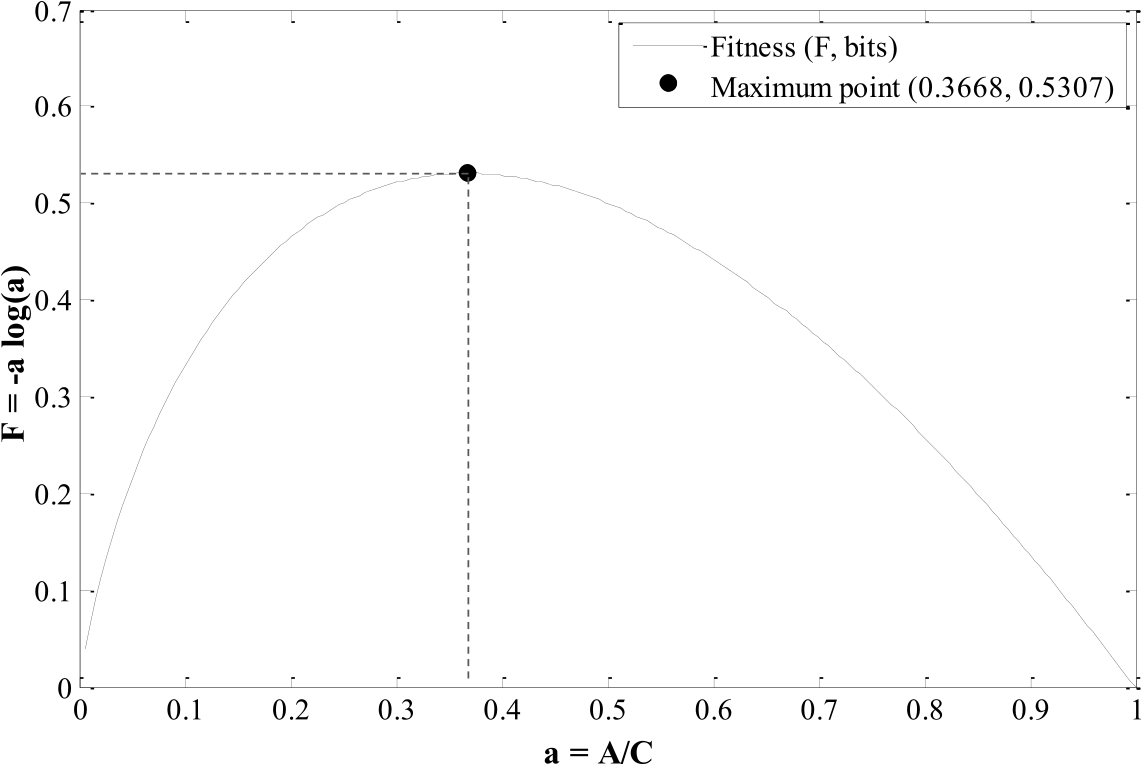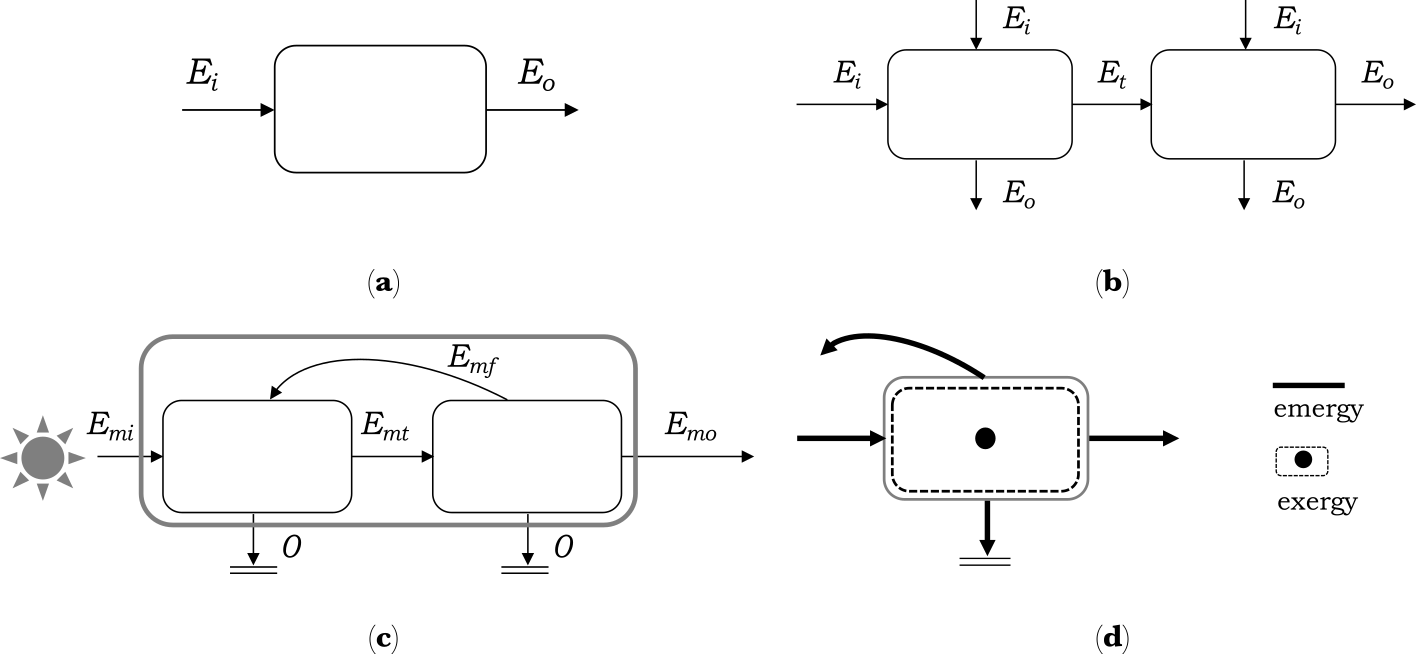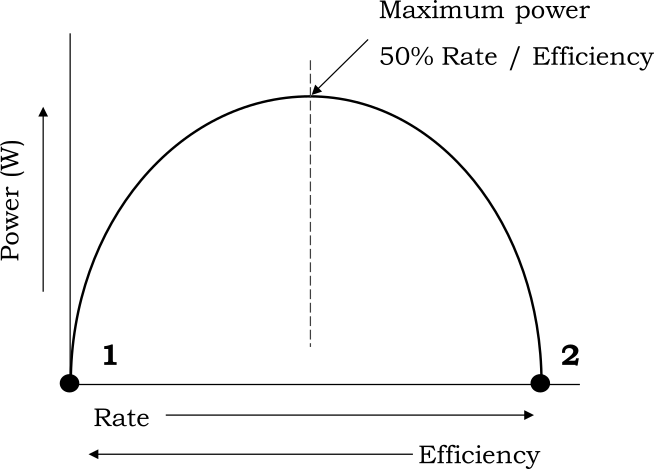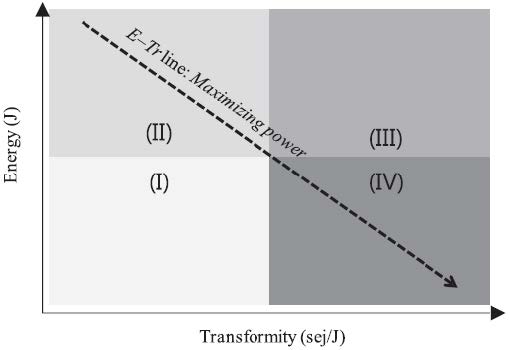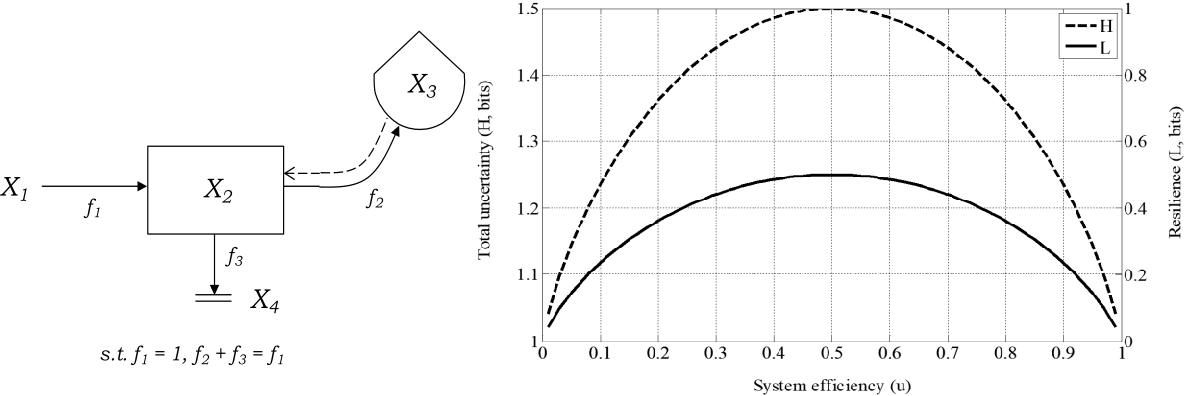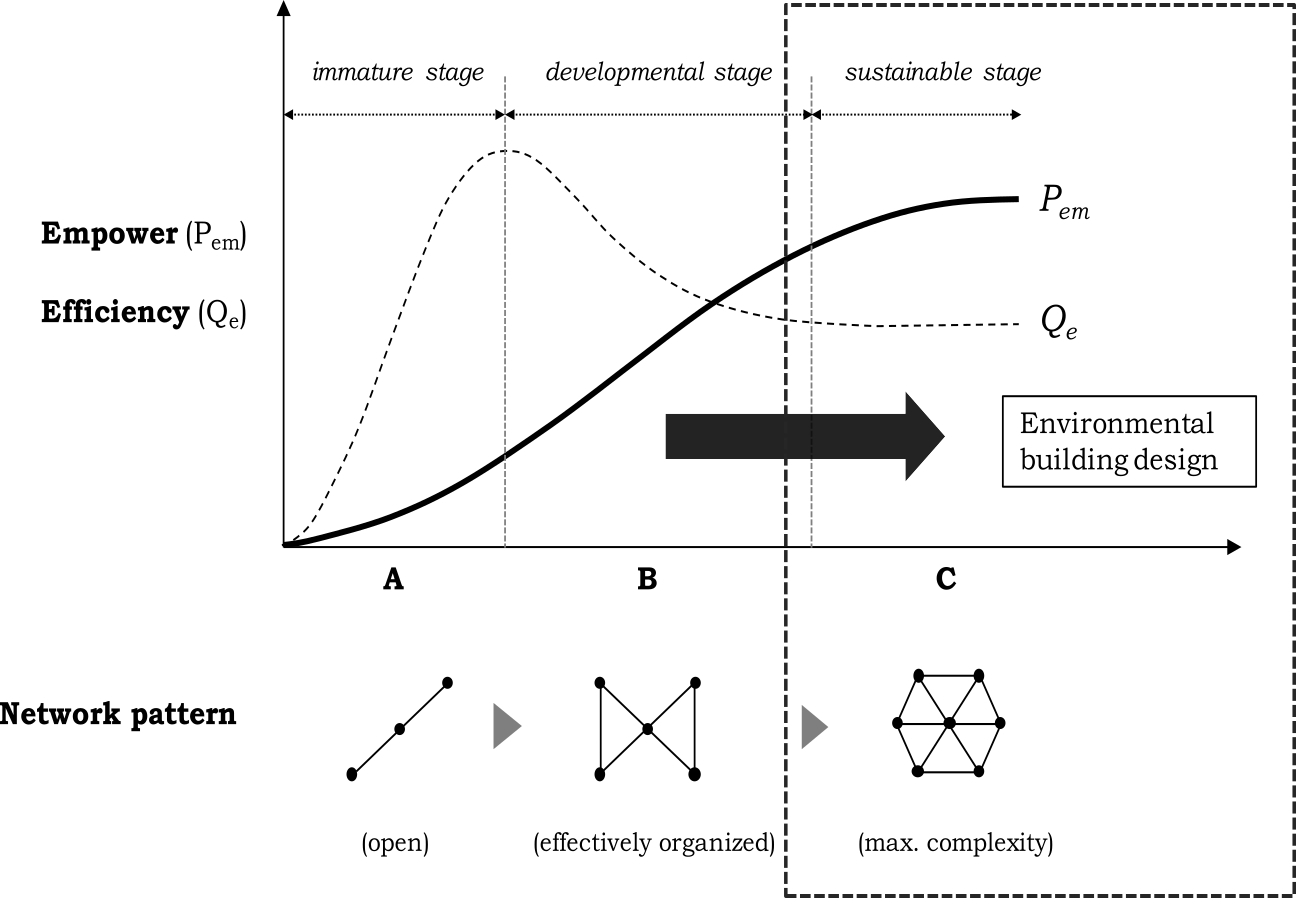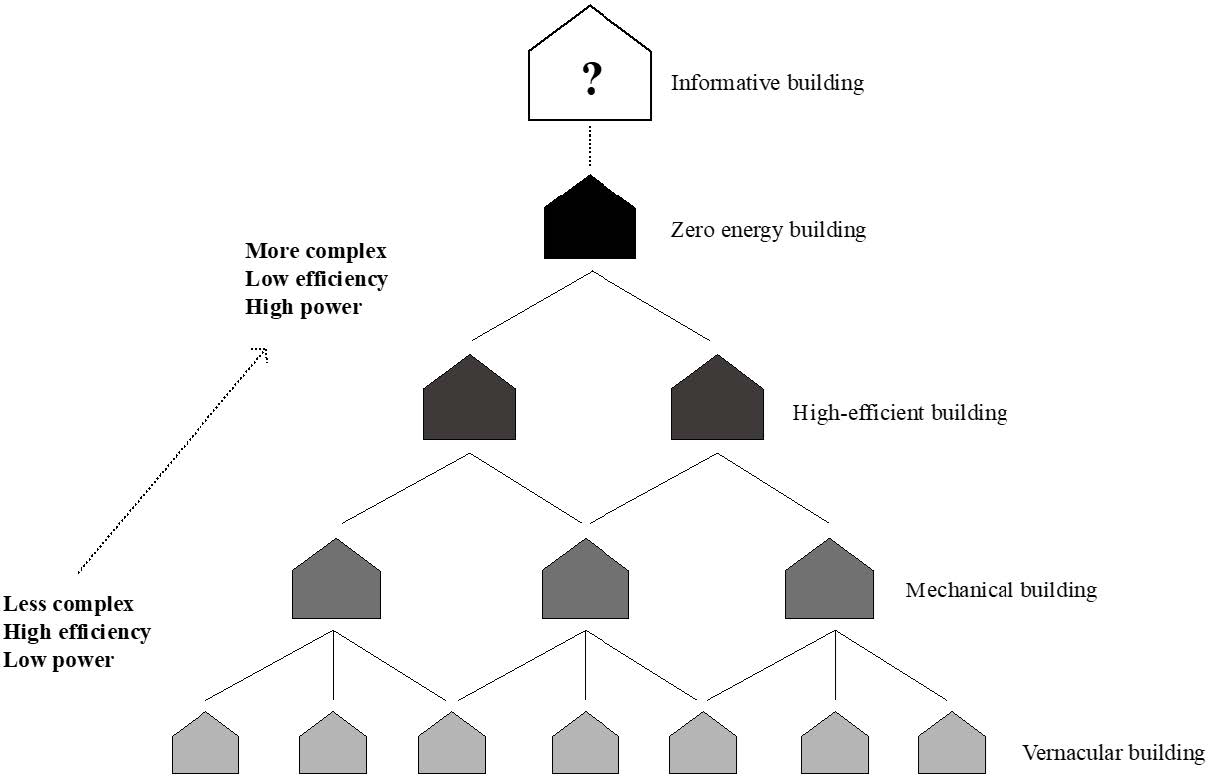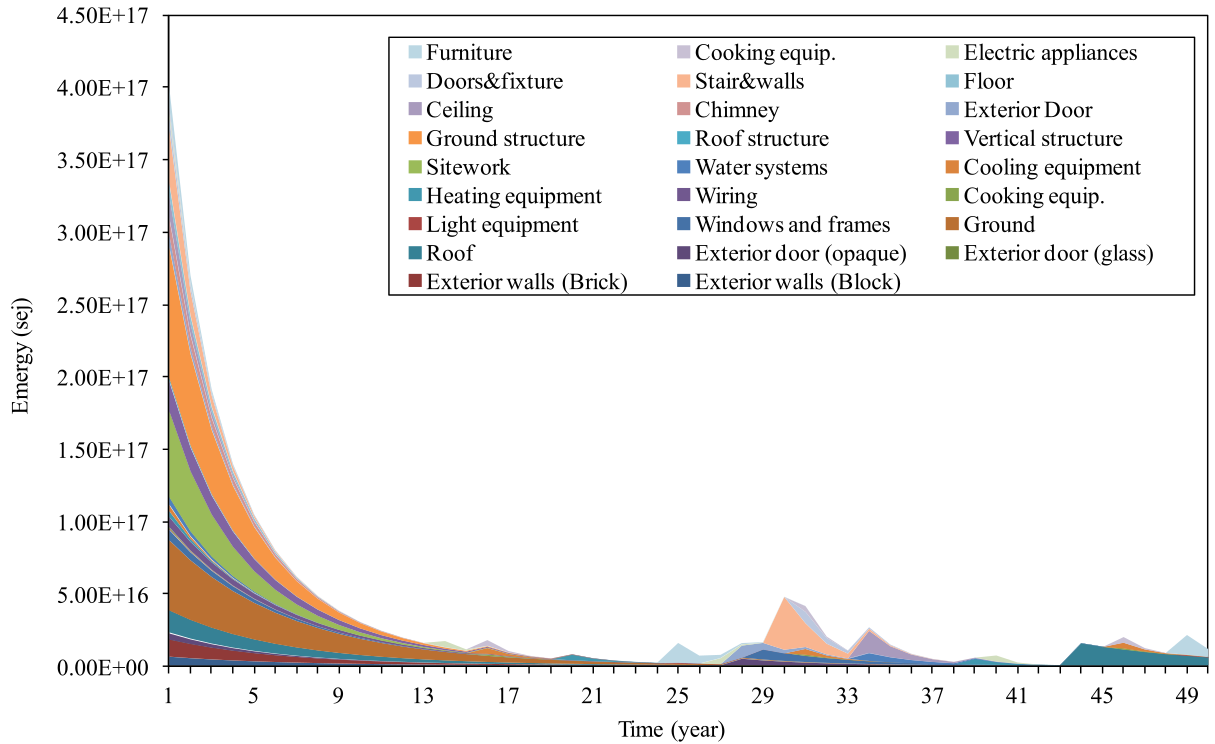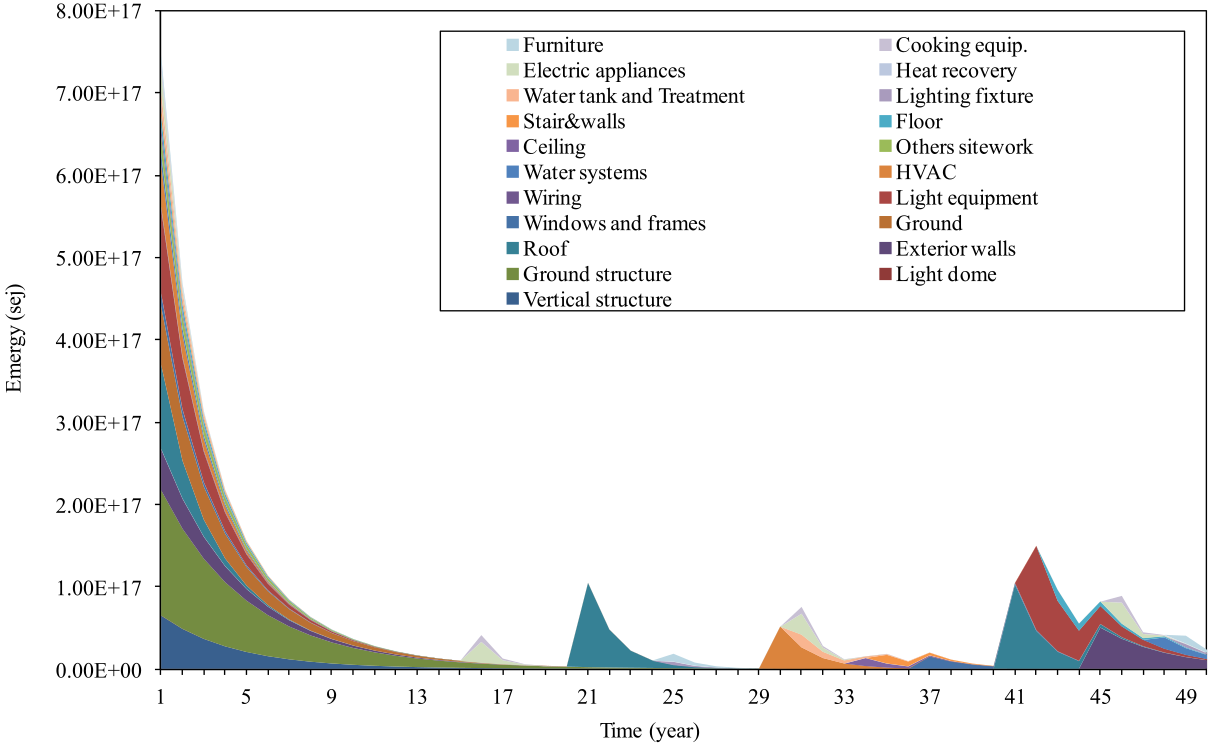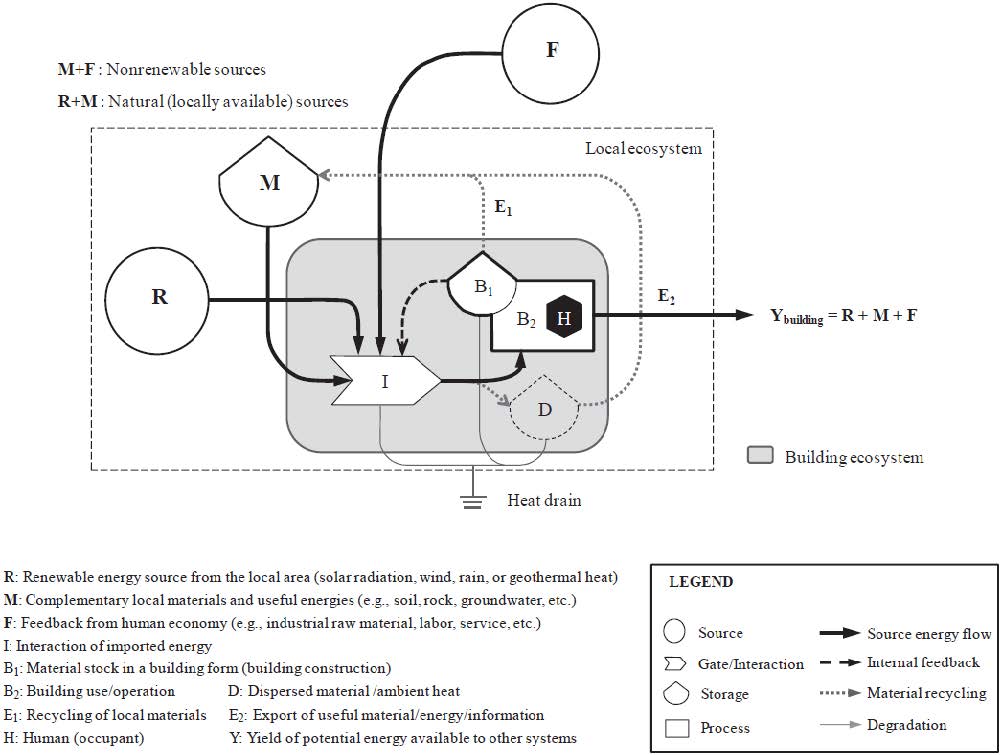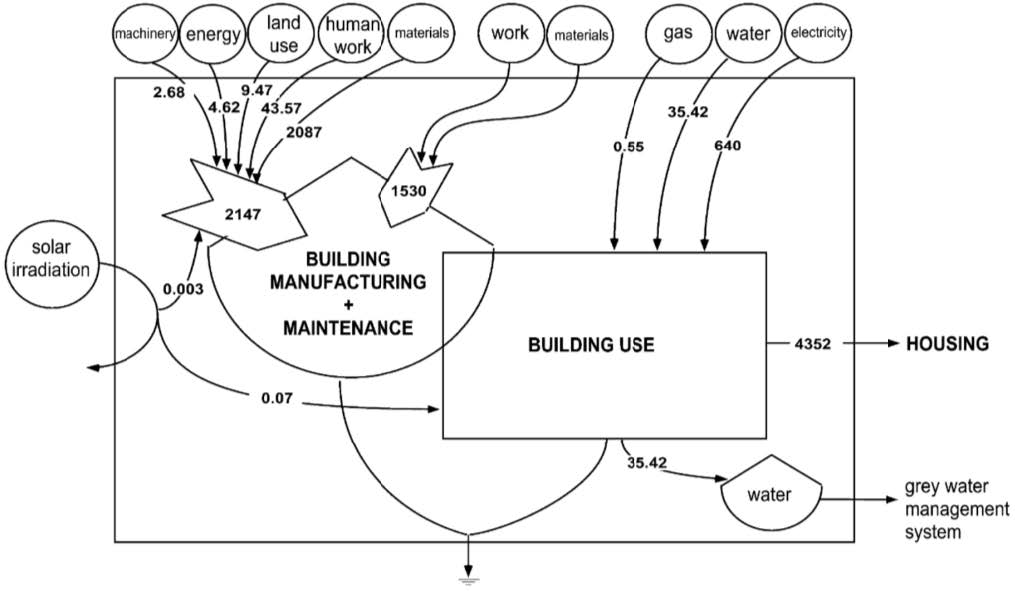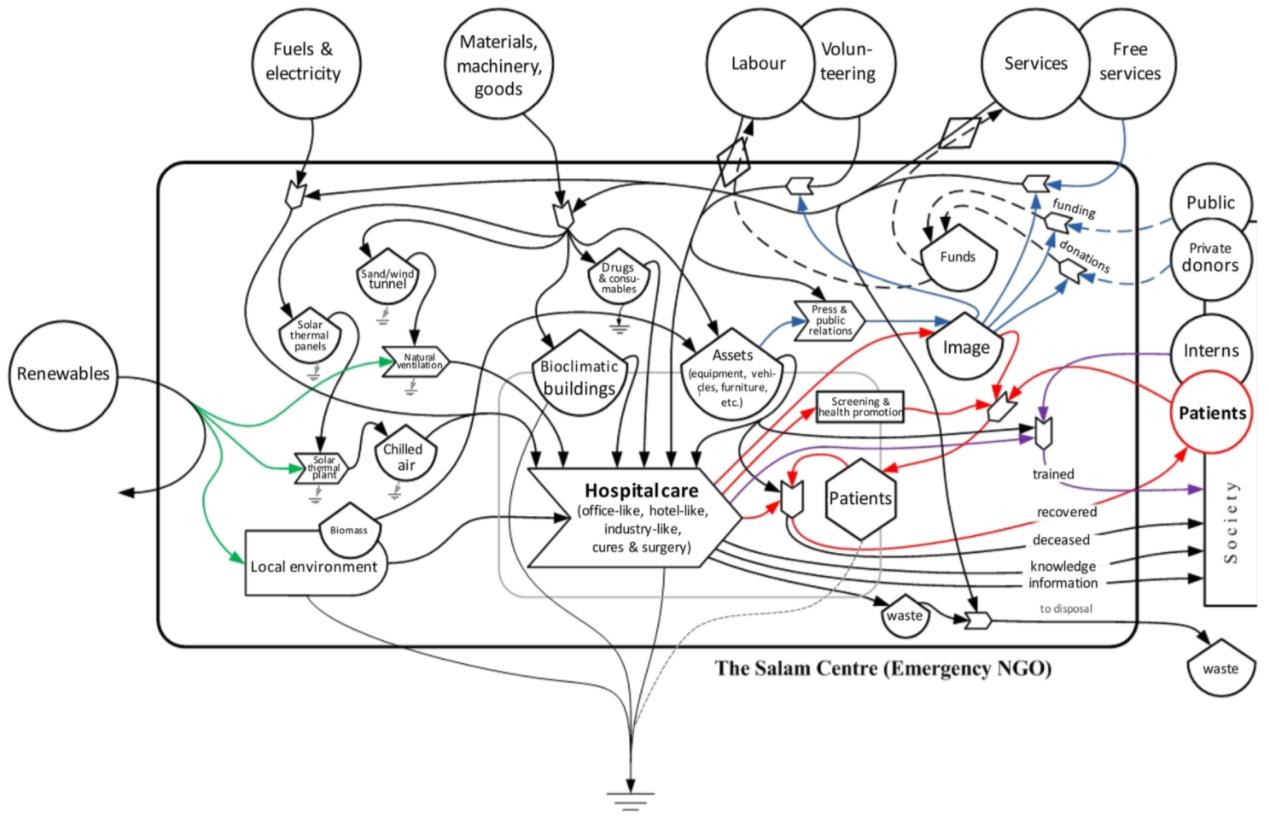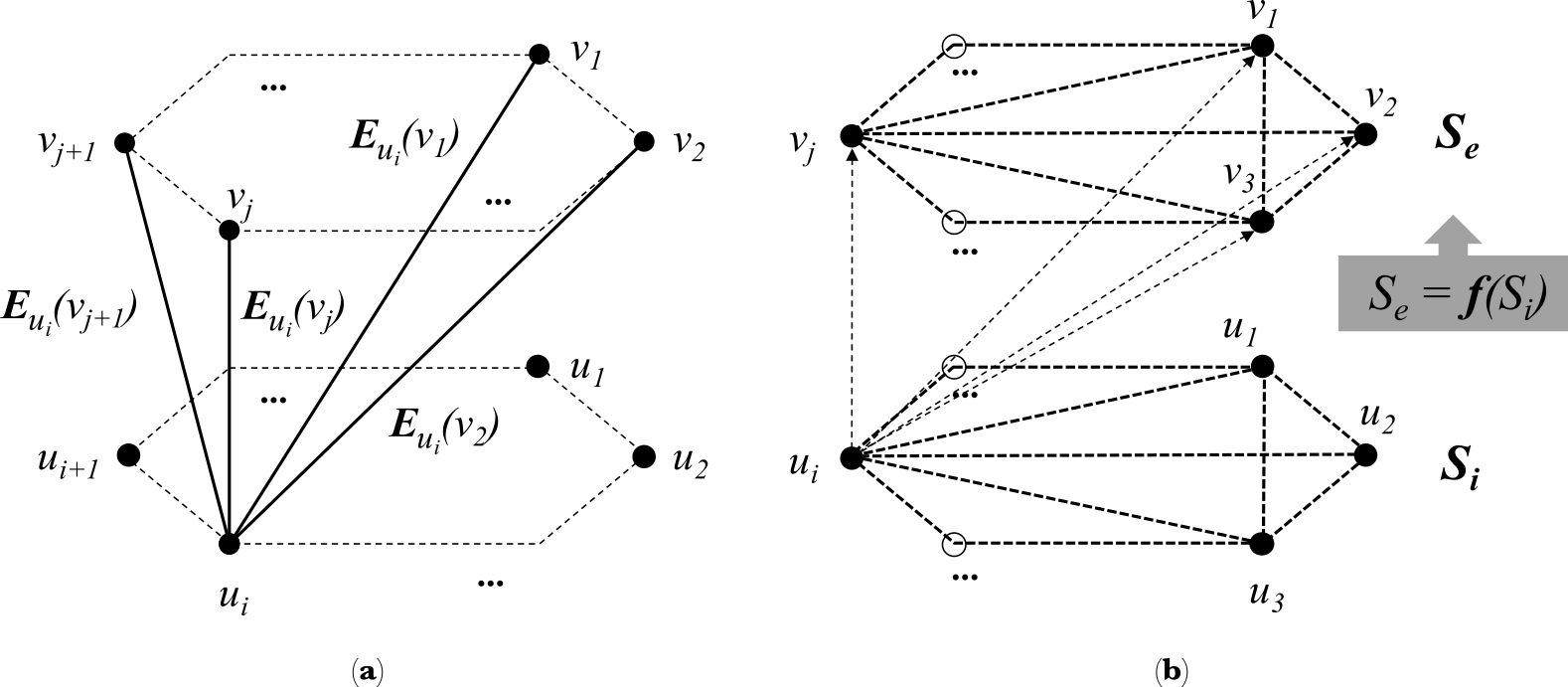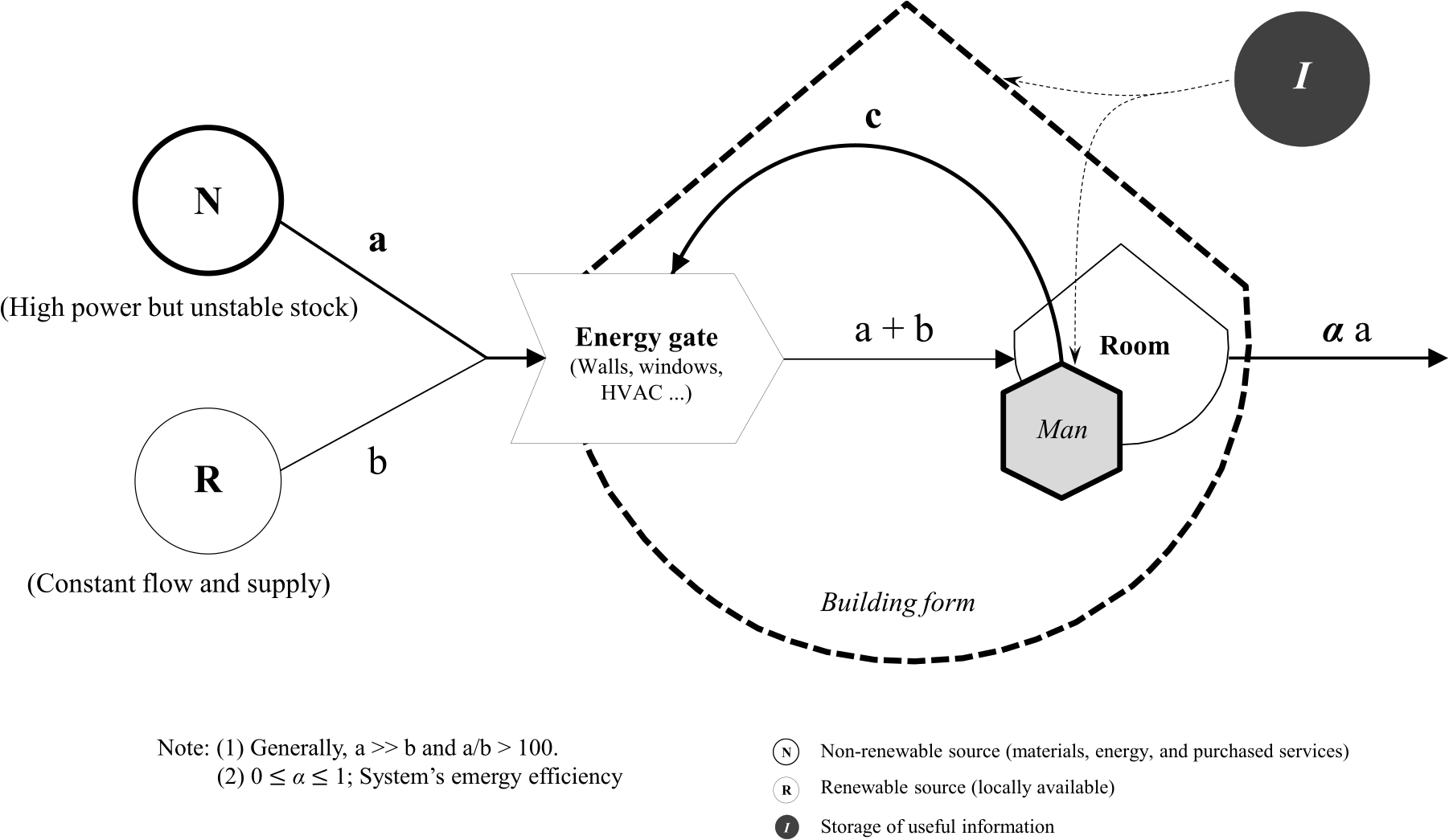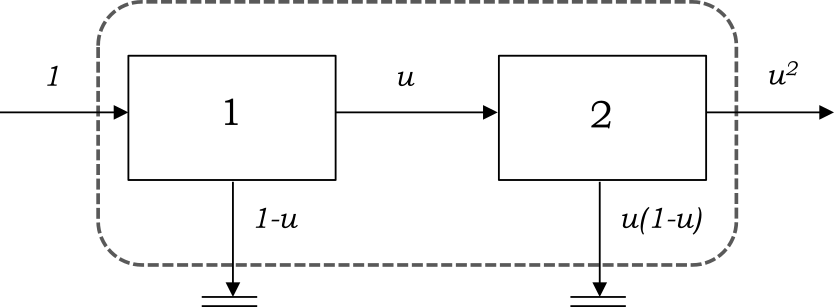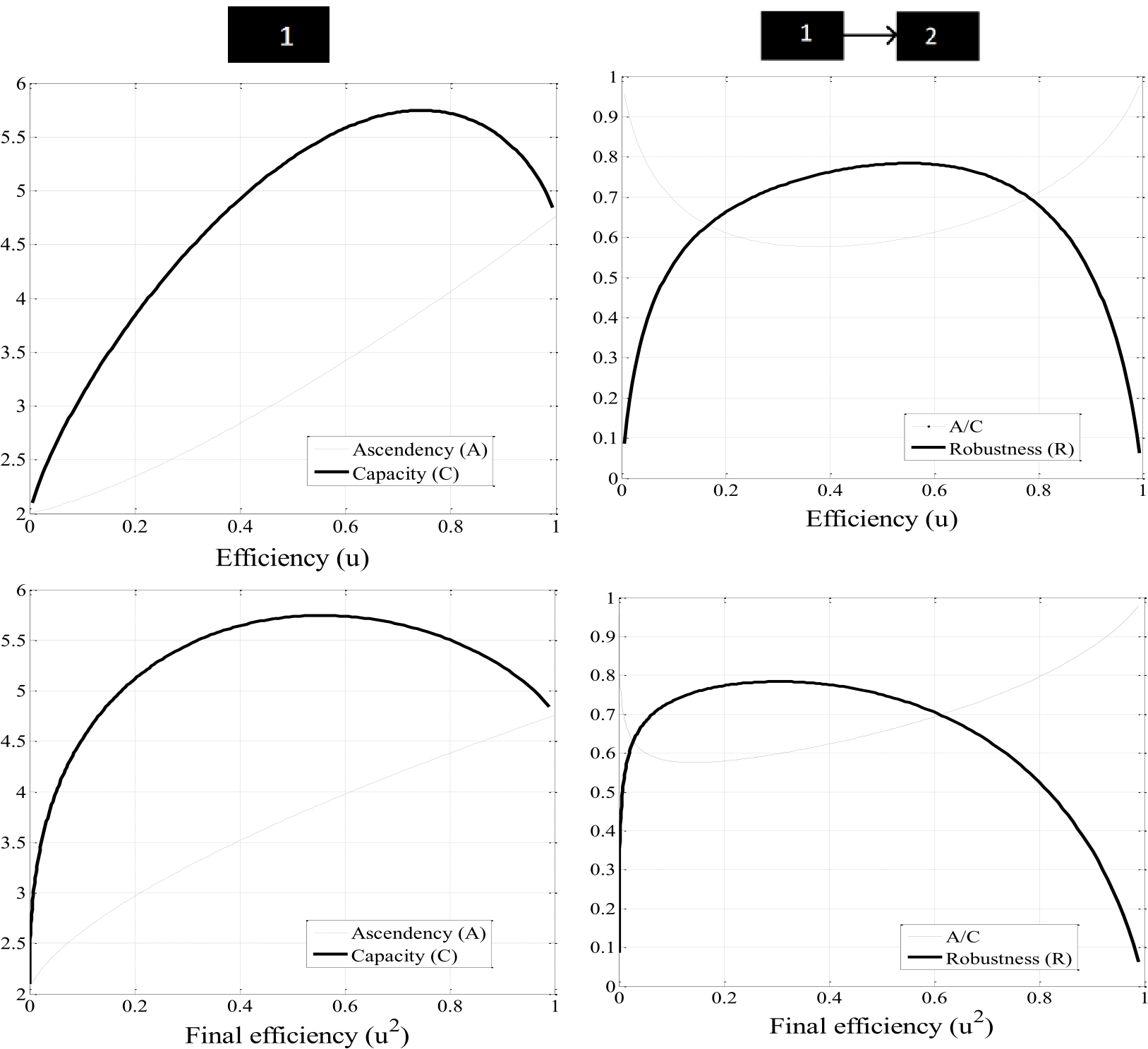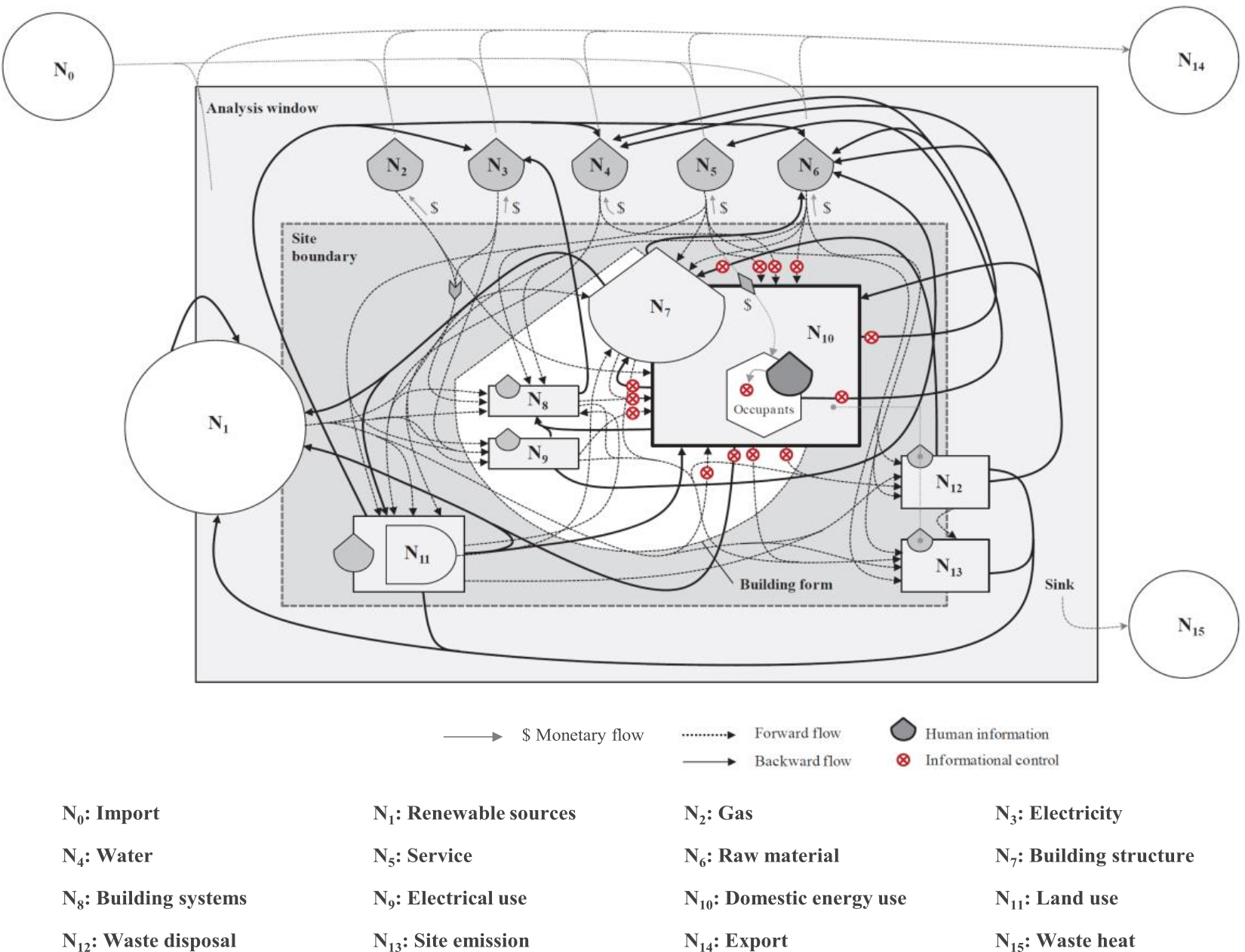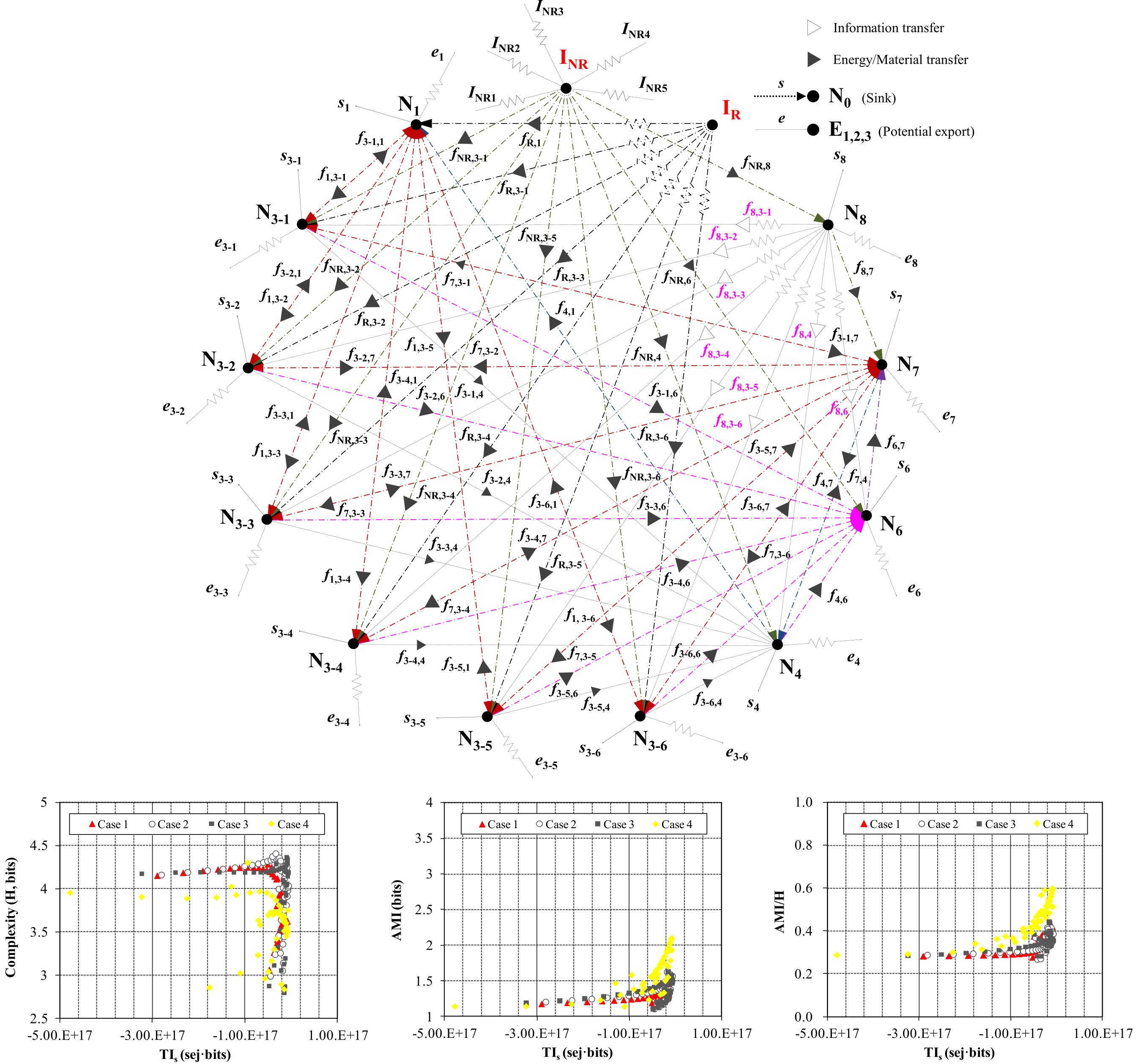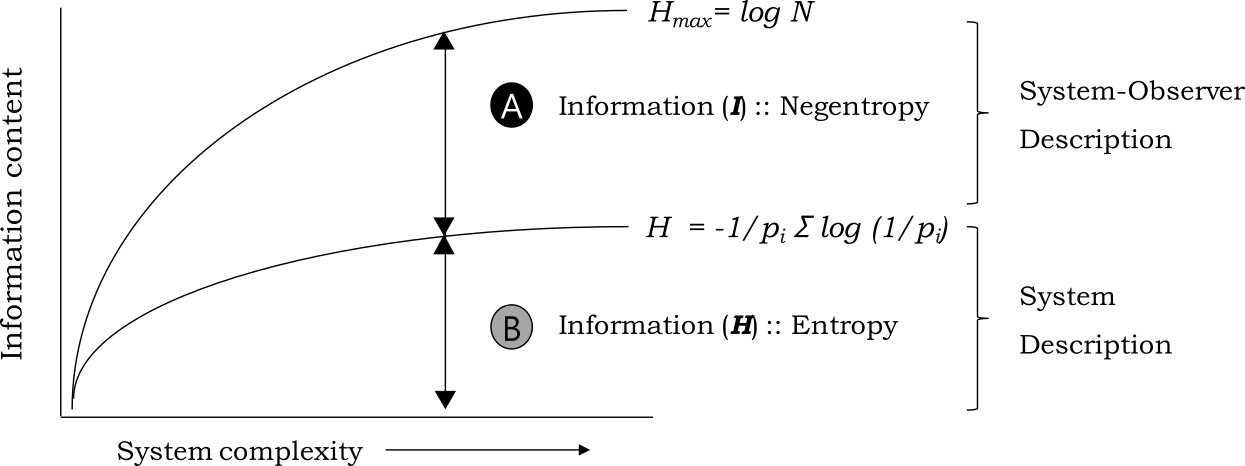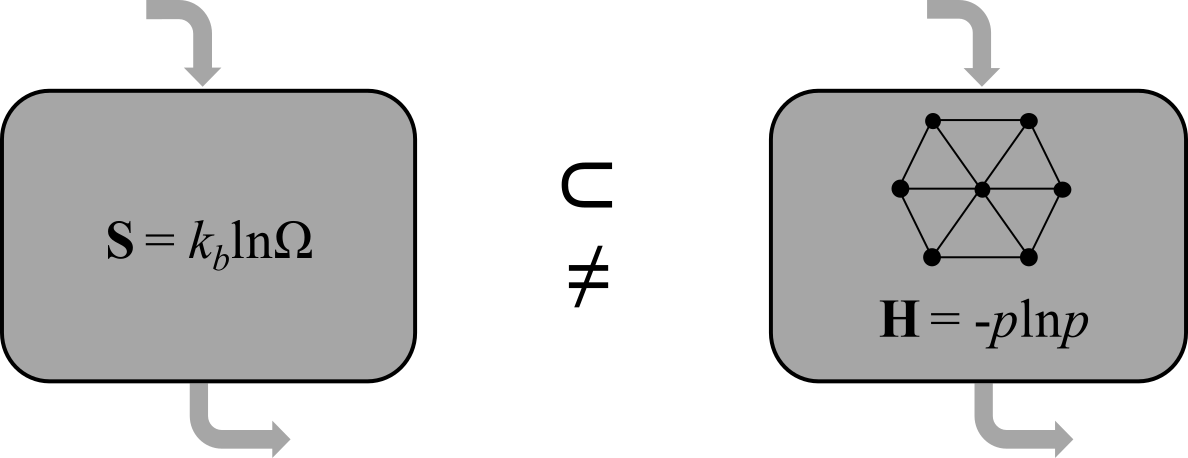Review Peer-Reviewed
Beyond Energy Efficiency in Building Sustainability: A Review of Emergy and Information for Systemically Characterizing Building Performance
Department of Architecture, Ajou University, Suwon, Gyeonggi-do 16499, South Korea
*
For correspondence.
Academic Editor:
Received: 8 December 2021 Accepted: 6 March 2022 Published: 8 March 2022
This article is part of the Special Issue Energy Efficiency and Renewable Energy.
Abstract
Sustainable buildings tend to maximize power and information rather than efficiency. The multidimensional concepts and tools provided by systems ecology and thermodynamics aid the understanding of building performance and sustainability as part of the global and complex thermodynamic phenomena in living systems—energy is not concentrated, but it flows, increasing the flow rate of useful energy. From such an extended macroscopic perspective, this paper addresses holistic eco-systemic criteria of building performance evaluation, focusing on emergy (spelled with an “m”) and information—the two critical indices of extensive and intensive analysis. Emergy aggregates the utmost and upstream energetic impacts, whereas information evaluates the structural pattern of the energy-flow distribution. These indices are theoretically correlated under the principles of ecological energy transformation and are often practically compatible. To clarify the definitions and appropriate scientific contexts of the new indices for environmental building studies, we review information theory, ecological theorems, and a few pioneering studies. Emergy and information have a great potential for advanced environmental building analysis, but building-scale implementation of emergy, information, and system principles remains a scientific challenge. The findings call for further research into the improvement of building-specific emergy/information data and reliable evidence of the analogy between building and open living systems.
Figures in this Article
Keywords
building performance; emergy; information; building sustainability; energy efficiency; maximum power
Copyright © 2022
Yi and Mehrotra. This article is distributed under the terms of the Creative Commons Attribution License (CC BY 4.0), which permits unrestricted use and distribution provided that the original work is properly cited.
Funding
This work was supported by grants from the National Research Foundation of Korea (NRF) funded by the Korean government (MSIT) (No. NRF-2019R1A2C100913012 and No. NRF-2021R1C1C1003403).
Cite this Article
ACS Style
Yi, H.; Mehrotra, A. Beyond Energy Efficiency in Building Sustainability: A Review of Emergy and Information for Systemically Characterizing Building Performance. Highlights Sustain. 2022, 1, 12–40. https://doi.org/10.54175/hsustain1010003
APA Style
Yi, H., & Mehrotra, A. (2022). Beyond Energy Efficiency in Building Sustainability: A Review of Emergy and Information for Systemically Characterizing Building Performance. Highlights of Sustainability, 1(1), 12–40. https://doi.org/10.54175/hsustain1010003
References
1.
Bean, R. Factor E5 = Energy • Efficiency • Entropy • Exergy • Efficacy. Available online: https://www.healthyheating.com/Low_Exergy_Systems/Energy_Efficiency_Entropy_Exergy_Efficacy.htm#.YDuiTugzZPY (accessed 22 February 2021).
2.
Pacheco, R.; Ordóñez, J.; Martínez, G. Energy efficient design of building: A review. Renew. Sustain. Energy Rev. 2012, 16, 3559–3573. https://doi.org/10.1016/j.rser.2012.03.045
3.
Norford, L. Energy Accounts: Architecture Representations of Energy, Climate and the Future. Technol. Archit. Des. 2018, 2, 114–115. https://doi.org/10.1080/24751448.2018.1420970
4.
Sampson, S.D. Life as an agent of energy dispersal. In What Is Your Dangerous Idea?; Happer Collins Publishers: New York, NY, USA, 2007; pp. 29–32.
5.
Srinivasan, R.S.; Braham, W.W.; Campbell, D.E.; Curcija, C.D. Re(De)fining Net Zero Energy: Renewable Emergy Balance in environmental building design. Build. Environ. 2012, 47, 300–315. https://doi.org/10.1016/j.buildenv.2011.07.010
6.
Yi, H.; Srinivasan, R.S.; Braham, W.W.; Tilley, D.R. An ecological understanding of net-zero energy building: Evaluation of sustainability based on emergy theory. J. Clean. Prod. 2017, 143, 654–671. http://dx.doi.org/10.1016/j.jclepro.2016.12.059
7.
Odum, H.T. Environment, Power and Society for the Twenty-First Century: The Hierarchy of Energy; Columbia University Press: New York, NY, USA, 2007; pp. 1–432.
8.
Pless, S.; Torcellini, P. Net-Zero Energy Buildings: A Classification System Based on Renewable Energy Supply Options; National Renewable Energy Laboratory: Golden, CO, USA, 2010; pp. 1–14.
9.
Braham, W.W. Architecture, style, and power: the work of civilization. In Architecture and Energy Performance and Style, 1st ed.; Braham, W.W., Willis, D., Eds.; Routledge: Oxfordshire, England, UK, 2013; pp. 9–24.
10.
Abel, T. Human transformities in a global hierarchy: Emergy and scale in the production of people and culture. Ecol. Modell. 2010, 221, 2112–2117. https://doi.org/10.1016/j.ecolmodel.2010.05.014
11.
Abel, T. Emergy evaluation of DNA and culture in ‘information cycles’. Ecol. Modell. 2013, 251, 85–98. https://doi.org/10.1016/j.ecolmodel.2012.11.027
12.
Fernández-Galiano, L. Architecture and Life. In Architecture and Energy Performance and Style, 1st ed.; Braham, W.W., Willis, D., Eds.; Routledge: Oxfordshire, England, UK, 2013; pp. 25–48.
13.
Braham, W.W. Environmental Building Design: Forms of Emergy. In Emergy Synthesis 7: Theory and Applications of the Emergy Methodology, Proceedings of the 7th Biennial Emergy Research Conference, Gainesville, FL, USA, 12–14 January 2012; Brown, M.T., Eds.; pp. 141–146.
14.
Munda, G. Social multi-criteria evaluation for urban sustainability policies. Land Use Policy 2006, 23, 86–94. https://doi.org/10.1016/j.landusepol.2004.08.012
15.
Jørgensen, S.E. Integration of ecosystem theories: A Pattern, 2nd ed.; Kluwer Academic Publishers: Dordrecht, BS, USA, 1992.
16.
Reed, M.; Fraser, E.D.G.; Morse, S.; Dougill, A.J. Integrating methods for developing sustainability indicators to facilitate learning and action. Ecol. Soc. 2005, 10, r3. https://doi.org/10.5751/ES-01296-1001R03
17.
Meadows, D.H.; Wright, D. Thinking in Systems: A Primer; Chelsea Green Publishing: White River Junction, VT, USA, 2008.
18.
Czech, B.; Krausman, P.R. Implications of an Ecosystem Management Literature Review. Wildl. Soc. Bull. 1997, 25, 667–675.
19.
Bossel, H. Assessing Viability and Sustainability: A Systems-Based Approach for Deriving Comprehensive Indicator Sets. Conserv. Ecol. 2001, 5, 12.
20.
Munda, G. “Measuring Sustainability”: A Multi-Criterion Framework. Environ. Dev. Sustain. 2005, 7, 117–134. https://doi.org/10.1007/s10668-003-4713-0
21.
Odum, E.P. The strategy of ecosystem development: An understanding of ecological succession provides a basis for resolving man’s conflict with nature. Science 1969, 164, 262–270. https://doi.org/10.1126/science.164.3877.262
22.
Schneider, E.D.; Kay, J.J. Life as Manifestation of the Second Law of Thermodynamics. Math. Comput. Model. 1994, 19, 25–48. https://doi.org/10.1016/0895-7177(94)90188-0
23.
Braham, W.W. Biotechniques: Form Follows Flow? In Proceedings of the Unites States Green Building Council / Greenbuild 2003 Conference and Exposition, Pittsburgh, PA, USA, 2003.
24.
Zhang, Y.; Singh, S.; Bakshi, B.R. Accounting for Ecosystem Services in Life Cycle Assessment, Part I: A Critical Review. Environ. Sci. Technol. 2010, 44, 2232–2242. https://doi.org/10.1021/es9021156
25.
Kharrazi, A.; Rovenskaya, E.; Fath, B.D.; Yarime, M.; Kraines, S. Quantifying the sustainability of economic resource networks: An ecological information-based approach. Ecol. Econ. 2013, 90, 177–186. https://doi.org/10.1016/j.ecolecon.2013.03.018
26.
White, L.A. The Science of Culture: A Study of Man and Civilization; Grove Press: New York, NY, USA, 1949.
27.
Fernández-Galiano, L. Fire and Memory; The MIT Press: Cambridge, MA, USA, 2000.
28.
ASHRAE. Energy Standard for Buildings except Low-Rise Residential Buildings; Thomson Reuters LLC: Atlanta, GA, USA, 2013.
29.
Herendeen, R.A. Energy analysis and EMERGY analysis-a comparison. Ecol. Modell. 2004, 178, 227–237. https://doi.org/10.1016/j.ecolmodel.2003.12.017
30.
Odum, H.T.; Odum, E.C. Energy Basis for Man and Nature; McGraw-Hill: New York, NY, USA, 1976.
31.
Moran, M.; Shapiro, H.N.; Boettner, D.D.; Bailey, M.B. Fundamentals of Engineering Thermodynamics, 8th ed.; John Wiley & Sons Inc.: Hoboken, NJ, USA, 2000; pp. 1–1042.
32.
Dincer, I.; Cengel, Y.A. Energy, Entropy and Exergy Concepts and Their Roles in Thermal Engineering. Entropy 2001, 3, 116–149. https://doi.org/10.3390/e3030116
33.
Jørgensen, S.E.; Mejer, H. A holistic approach to ecological modelling. Ecol. Modell. 1979, 7, 169–189. https://doi.org/10.1016/0304-3800(79)90068-1
34.
Bullard, C.W.; Penner, P.S.; Pilati, D.A. Net Energy Analysis: Handbook for Combining Process and Input-Output Analysis. Resour. Energy 1978, 1, 267–313.
35.
Buranakarn, V. Evaluation of recycling and reuse of building materials using the emergy analysis method. Ph.D. Thesis, University of Florida, Gainesville, FL, USA, 1998.
36.
Odum, H.T. Environmental Accounting: EMERGY and Environmental Decision Making; John Wiley and Sons, Inc.: Edison, NJ, USA, 1996.
37.
Brown, M.T.; Ulgiati, S. Energy quality, emergy, and transformity: H.T. Odum’s contributions to quantifying and understanding systems. Ecol. Modell. 2004, 178, 201–213. https://doi.org/10.1016/j.ecolmodel.2004.03.002
38.
Bastianoni, S.; Facchini, A.; Susani, L.; Tiezzi, E. Emergy as a function of exergy. Energy 2007, 32, 1158–1162. https://doi.org/10.1016/j.energy.2006.08.009
39.
Kharrazi, A.; Kraines, S.; Hoang, L.; Yarime, M. Advancing quantification methods of sustainability: A critical examination emergy, exergy, ecological footprint, and ecological information-based approaches. Ecol. Indic. 2014, 37, 81–89. https://doi.org/10.1016/j.ecolind.2013.10.003
40.
Brown, M.T.; Ulgiati, S. Emergy-based indices and ratios to evaluate sustainability: monitoring economies and technology toward environmentally sound innovation. Ecol. Eng. 1997, 9, 51–69. https://doi.org/10.1016/S0925-8574(97)00033-5
41.
Morandi, F.; Campbell, D.E.; Pulselli, R.M.; Bastianoni, S. Using the language of sets to describe nested systems in emergy evaluations. Ecol. Modell. 2013, 265, 85–98. https://doi.org/10.1016/j.ecolmodel.2013.06.006
42.
Tribus, M.; McIrvine, E.C. Energy and Information. Sci. Am. 1971, 225, 179–190.
43.
Odum, H.T. Self-Organization, Transformity, and Information. Science 1988, 242, 1132–1139. https://doi.org/10.1126/science.242.4882.1132
44.
Nyquist, H. Certain factors affecting telegraph speed. Bell Syst. Tech. J. 1924, 3, 324–346. https://doi.org/10.1002/j.1538-7305.1924.tb01361.x
45.
Shannon, C.E. A mathematical theory of communication. Bell Syst. Tech. J. 1948, 27, 379–423. https://doi.org/10.1002/j.1538-7305.1948.tb01338.x
46.
Rutledge, R.W.; Basore, B.L.; Mulholland, R.J. Ecological stability: An information theory view point. J. Theor. Biol. 1976, 57, 355–371. https://doi.org/10.1016/0022-5193(76)90007-2
47.
Latham, L.G., II; Scully, E.P. Quantifying constraint to assess development in ecological networks. Ecol. Modell. 2002, 154, 25–44. https://doi.org/10.1016/S0304-3800(02)00032-7
48.
Hirata, H.; Ulanowicz, R.E. Information theoretical analysis of ecological networks. Int. J. Syst. Sci. 1984, 15, 261–270. https://doi.org/10.1080/00207728408926559
49.
Ulanowicz, R.E. The dual nature of ecosystem dynamics. Ecol. Modell. 2009, 220, 1886–1892. https://doi.org/10.1016/j.ecolmodel.2009.04.015
50.
Ulanowicz, R.E. An Hypothesis on the Development of Natural Communities. J. Theor. Biol. 1980, 85, 223–245. https://doi.org/10.1016/0022-5193(80)90019-3
51.
Ulanowicz, R.E. Ecology, the Ascendent Perspective; Columbia University Press: New York, NY, USA, 1997.
52.
Ulanowicz, R.E. Quantifying sustainable balance in ecosystem configurations. Curr. Res. Environ. Sustain. 2020, 1, 1–6. https://doi.org/10.1016/j.crsust.2019.09.001
53.
Zhou, J.; Ma, S.; Hinman, G.W. Ecological exergy analysis: a new method for ecological energetic research. Ecol. Modell. 1996, 84, 291–303. https://doi.org/10.1016/0304-3800(94)00135-9
54.
Brown, M.T.; Cohen, M.J. Emergy and Network Analysis. In Encyclopedia of Ecology; Fath, B., Eds.; Academic Press: Oxford, UK, 2008; pp. 1229–1239.
55.
Cai, T.T.; Olsen, T.W.; Campbell, D.E. Maximum (em)power: a foundational principle linking man and nature. Ecol. Modell. 2004, 178, 115–119. https://doi.org/10.1016/j.ecolmodel.2003.12.009
56.
Tilley, D.R. Howard T. Odum’s contribution to the laws of energy. Ecol. Modell. 2004, 178, 121–125. https://doi.org/10.1016/j.ecolmodel.2003.12.032
57.
Fath, B.D.; Cabezas, H.; Pawlowski, C.W. Regime changes in ecological systems: an information theory approach. J. Theor. Biol. 2003, 222, 517–530. https://doi.org/10.1016/S0022-5193(03)00067-5
58.
Eason, T.; Cabezas, H. Evaluating the sustainability of a regional system using Fisher information in the San Luis Basin, Colorado. J. Environ. Manag. 2012, 94, 41–49. https://doi.org/10.1016/j.jenvman.2011.08.003
59.
Karunanithi, A.T.; Cabezas, H.; Frieden, B.R.; Pawlowski, C.W. Detection and Assessment of Ecosystem Regime Shifts from Fisher Information. Ecol. Soc. 2008, 13, 22. https://doi.org/10.5751/ES-02318-130122
60.
Schrödinger, E. What is life? The Physical Aspect of the Living Cell; The Cambridge University press: New York, NY, USA, 1944.
61.
Lotka, A.J. Natural Selection as a Physical Principle. Proc. Natl. Acad. Sci. USA 1922, 8, 151–154. https://doi.org/10.1073/pnas.8.6.151
62.
Jaynes, E.T. Information Theory and Statistical Mechanics. Phys. Rev. 1957, 106, 620–630. https://doi.org/10.1103/PhysRev.106.620
63.
Ziegler, H. Some extremum principles in irreversible thermodynamics with application to continuum mechanics. In Progress in Solid Mechanics; Sneddon, I.N., Hill, R., Eds.; Nort-Holland Publishing Company: Amsterdam, Holland, 1963. https://doi.org/10.1002/zamm.19650450443
64.
Harte, J. Maximum Entropy and Ecology: A Theory of Abundance, Distribution, and Energetics; Oxford University Press: Oxford, UK, 2011. https://doi.org/10.1093/acprof:oso/9780199593415.001.0001
65.
Brinck, K. Information Entropy and Ecological Energetics: Predicting and Analysing Structure and Energy Flow in Ecological Networks applying the Concept of MaxEnt. Master’s Thesis, University of California, Berkeley, Berkeley, CA, USA, 2014.
66.
Martyushev, L.M. Entropy and Entropy Production: Old Misconceptions and New Breakthroughs. Entropy 2013, 15, 1152–1170. https://doi.org/10.3390/e15041152
67.
Brillouin, L. Thermodynamics, Statistics, and Information. Am. J. Phys. 1961, 29, 318–328. https://doi.org/10.1119/1.1937760
68.
MacArthur, R. Fluctuations of animal populations, and a measure of community stability. Ecology 1955, 36, 533–536. https://doi.org/10.2307/1929601
69.
Margalef, D.R. La teoria de la informacion en ecologia (Information theory in ecology) (in Spanish). Mem. Real Acad. Cienc. Artes Barc. 1957, 32, 373–449.
70.
Gudmundsson, A.; Mohajeri, N. Entropy and order in urban street networks. Sci. Rep. 2013, 3, 3324. https://doi.org/10.1038/srep03324
71.
Torío, H.; Angelotti, A.; Schmidt, D. Exergy analysis of renewable energy-based climatisation systems for buildings: A critical view. Energy Build. 2009, 41, 248–271. https://doi.org/10.1016/j.enbuild.2008.10.006
72.
O’Connor, M.I.; Pennell, M.W.; Altermatt, F.; Matthews, B.; Melián, C. J.; Gonzalez, A. Principles of Ecology Revisited: Integrating Information and Ecological Theories for a More Unified Science. Front. Ecol. Evol. 2019, 7, 219. https://doi.org/10.3389/fevo.2019.00219
73.
Braham, W.W. Architecture and Systems Ecology, 1st ed.; Routledge: England, UK, 2015; pp. 1–276.
74.
Braham, W.W.; Yi, H. Hierarchies of Production in a Contemporary Residence. In Emergy Synthesis 8: Theory and Applications of the Emergy Methodology, Proceedings of the 8th Biennial Emergy Research Conference, Gainesville, FL, USA, 16–18 January 2014; Brown, M.T., Eds.; pp. 101–116.
75.
Amaral, L.P.; Martins, N.; Gouveia, J.B. A review of emergy theory, its application and latest developments. Renew. Sustain. Energy Rev. 2016, 54, 882–888. https://doi.org/10.1016/j.rser.2015.10.048
76.
Chen, W.; Liu, W.; Geng, Y.; Brown, M.T.; Gao, C.; Wu, R. Recent progress on emergy research: A bibliometric analysis. Renew. Sustain. Energy Rev. 2017, 73, 1051–1060. https://doi.org/10.1016/j.rser.2017.02.041
77.
He, S.; Zhu, D.; Chen, Y.; Liu, X.; Chen , Y.; Wang, X. Application and problems of emergy evaluation: A systemic review based on bibliometric and content analysis methods. Ecol. Indic. 2020, 114, 106304. https://doi.org/10.1016/j.ecolind.2020.106304
78.
Reza, B.; Sadiq, R.; Hewage, K. Emergy-based life cycle assessment (Em-LCA) of multi-unit and single-family residential buildings in Canada. Int. J. Sustain. Built Environ. 2014, 3, 207–224. https://doi.org/10.1016/j.ijsbe.2014.09.001
79.
Srinivasan, R.S.; Ingwersen, W.; Trucco, C.; Ries , R.; Campbell, D. Comparison of energy-based indicators used in life cycle assessment tools for buildings. Build. Environ. 2014, 79, 138–151. https://doi.org/10.1016/j.buildenv.2014.05.006
80.
Li, D.; Zhu, J.; Hui, E.C.M.; Leung, B.Y.P.; Li, Q. An emergy analysis-based methodology for eco-efficiency evaluation of building manufacturing. Ecol. Indic. 2011, 11, 1419–1425. https://doi.org/10.1016/j.ecolind.2011.03.004
81.
Alizadeh, S.; Zafari-koloukhi, H.; Rostami, F.; Rouhbakhsh, M.; Avami, A. The eco-efficiency assessment of wastewater treatment plants in the city of Mashhad using emergy and life cycle analyses. J. Clean. Prod. 2020, 249, 119327. https://doi.org/10.1016/j.jclepro.2019.119327
82.
Brown, M.T.; Buranakarn, V. Emergy indices and ratios for sustainable material cycles and recycle options. Resour. Conserv. Recycl. 2003, 38, 1–22. https://doi.org/10.1016/S0921-3449(02)00093-9
83.
Meillaud, F.; Gay, J.-B.; Brown, M.T. Evaluation of a building using the emergy method. Sol. Energy 2005, 79, 204–212. https://doi.org/10.1016/j.solener.2004.11.003
84.
Pulselli, R.M.; Simoncini, E.; Pulselli, F.M.; Bastianoni, S. Emergy analysis of building manufacturing, maintenance and use: Em-building indices to evaluate housing sustainability. Energy Build. 2007, 39, 620–628. https://doi.org/10.1016/j.enbuild.2006.10.004
85.
Pulselli, R.M.; Simoncini, E.; Ridolfi, R.; Bastianoni, S. Specific emergy of cement and concrete: An energy-based appraisal of building materials and their transport. Ecol. Indic. 2008, 8, 647–656. https://doi.org/10.1016/j.ecolind.2007.10.001
86.
Pulselli, R.M.; Simoncini, E.; Marchettini, N. Energy and emergy based cost–benefit evaluation of building envelopes relative to geographical location and climate. Build. Environ. 2009, 44, 920–928. https://doi.org/10.1016/j.buildenv.2008.06.009
87.
Price, J.W.; Tilley, D.R. Emergy Evaluation of a Green Facade. In Emergy Synthesis 6: Theory and Applications of the Emergy Methodology, Proceedings of the 6th Biennial Emergy Research Conference, Gainesville, FL, USA, 14–16 January 2010; Brown, M.T., Eds.; pp. 213–222.
88.
Amponsah, N.Y.; Lacarrière, B.; Jamali-Zghal, N.; Le Corre, O. Impact of building material recycle or reuse on selected emergy ratios. Resour. Conserv. Recycl. 2012, 67, 9–17. https://doi.org/10.1016/j.resconrec.2012.07.001
89.
Rothrock, H. Sustainable housing: Emergy evaluation of an off-grid residence. Energy Build. 2014, 85, 287–292. https://doi.org/10.1016/j.enbuild.2014.08.002
90.
Pulselli, R.M.; Pulselli, F.M.; Mazzali, U.; Peron, F.; Bastianoni, S. Emergy based evaluation of environmental performances of Living Wall and Grass Wall systems. Energy Build. 2014, 73, 200–211. https://doi.org/10.1016/j.enbuild.2014.01.034
91.
Luo, Z.; Zhao, J.; Yao, R.; Shu, Z. Emergy-based sustainability assessment of different energy options for green buildings. Energy Convers. Manag. 2015, 100, 97–102. https://doi.org/10.1016/j.enconman.2015.04.072
92.
Thomas, T.; Praveen, A. Emergy parameters for ensuring sustainable use of building materials. J. Clean. Prod. 2020, 276, 122382. https://doi.org/10.1016/j.jclepro.2020.122382
93.
Cristiano, S.; Ulgiati, S.; Gonella, F. Systemic sustainability and resilience assessment of health systems, addressing global societal priorities: Learnings from a top nonprofit hospital in a bioclimatic building in Africa. Renew. Sustain. Energy Rev. 2021, 141, 110765. https://doi.org/10.1016/j.rser.2021.110765
94.
Yi, H.; Srinivasan, R.S.; Braham, W.W. An Integrated Energy-Emergy Approach to Building Form Optimization: Use of EnergyPlus, Emergy Analysis and Taguchi-Regression Method. Build. Environ. 2015, 84, 89–104. https://doi.org/10.1016/j.buildenv.2014.10.013
95.
Yi, H.; Braham, W.W. Uncertainty Characterization of Building Emergy Analysis (BEmA). Build. Environ. 2015, 92, 538–558. https://doi.org/10.1016/j.buildenv.2015.05.007
96.
Andrić, I.; Pina, A.; Ferrão, P.; Lacarrière, B.; Le Corre, O. The impact of renovation measures on building environmental performance: An emergy approach. J. Clean. Prod. 2017, 162, 776–790. https://doi.org/10.1016/j.jclepro.2017.06.053
97.
Odum, H.T.; Brown, M.T.; Whitfield, D.F.; Lopez, S.; Woithe, R.; Doherty, S. Zonal Organization of Cities and Environment. Unpublished report to the Chiang Ching-Kuo International Scholar Exchange Foundation, Taipei, Taiwan, 1995.
98.
Abel, T. The ‘Locations’ of Households within the Culture-Nature Hierarchy of Hualien County, Taiwan. In Emergy Synthesis 6: Theory and Applications of the Emergy Methodology, Proceedings of the 6th Biennial Emergy Research Conference, Gainesville, FL, USA, 14–16 January 2010; Brown, M.T., Eds.; pp. 461–482.
99.
Huang, S.L.; Lai, H.Y.; Lee, C.L. Energy hierarchy and urban landscape system. Landsc. Urban Plan. 2001, 53, 145–161. https://doi.org/10.1016/S0169-2046(00)00150-X
100.
Lee, Y.C.; Yeh, C.T.; Huang, S.L. Energy hierarchy and landscape sustainability. Landsc. Ecol. 2013, 28, 1151–1159. https://doi.org/10.1007/s10980-012-9706-7
101.
Lei, K.; Liu, L.; Hu, D.; Lou, I. Mass, energy, and emergy analysis of the metabolism of Macao. J. Clean. Prod. 2016, 114, 160–170. https://doi.org/10.1016/j.jclepro.2015.05.099
102.
Lee, J.M.; Braham, W.W. Building emergy analysis of Manhattan: Density parameters for high-density and high-rise developments. Ecol. Modell. 2017, 363, 157–171. https://doi.org/10.1016/j.ecolmodel.2017.08.014
103.
Huang, Y.; Liu, G.; Chen, C.; Yang, Q.; Wang, X.; Giannetti, B.F.; Zhang, Y.; Casazza, M. Emergy-based comparative analysis of urban metabolic efficiency and sustainability in the case of big and data scarce medium-sized cities: A case study for Jing-Jin-Ji region (China). J. Clean. Prod. 2018, 192, 621–638. https://doi.org/10.1016/j.jclepro.2018.05.012
104.
Lee, J.M.; Braham, W.W. Measuring public service quality: Revisiting residential location choice using emergy synthesis of local governments in Pennsylvania. Cities 2020, 102, 102753. https://doi.org/10.1016/j.cities.2020.102753
105.
Wiener, N. Cybernetics: Or Control and Communication in the Animal and the Machine, 2nd ed.; The MIT Press: Cambridge, MA, USA, 1948; pp. 1–212.
106.
Quastler, H. Essays on the use of information theory in biology; University of Illinois Press: Urbana, IL, USA, 1953; pp. 1–273.
107.
MacKay D.M. Information, Mechanism and Meaning; The MIT Press: Cambridge, MA, USA, 1969; pp. 1–206.
108.
Warner, J. Linguistics and information theory: Analytic advantages. J. Am. Soc. Inf. Sci. Technol. 2007, 58, 275–285. http://dx.doi.org/10.1002/asi.20488
109.
Karunanithi, A.T.; Garmestani, A.S.; Eason, T.; Cabezas, H. The characterization of socio-political instability, development and sustainability with Fisher information. Glob. Environ. Change 2011, 21, 77–84. https://doi.org/10.1016/j.gloenvcha.2010.11.002
110.
Balocco, C.; Grazzini, G. Sustainability and information in urban system analysis. Energy Policy 2006, 34, 2905–2914. https://doi.org/10.1016/j.enpol.2005.04.022
111.
Zhang, Y.; Yang, Z.; Li, W. Analyses of urban ecosystem based on information entropy. Ecol. Modell. 2006, 197, 1–12. https://doi.org/10.1016/j.ecolmodel.2006.02.032
112.
Pulselli, R.M.; Ratti, C.; Tiezzi, E. City out of chaos: Social patterns and organization in urban systems. WIT Trans. State Art Sci. Eng. 2011, 51, 193–202. https://doi.org/10.2495/978-1-84564-654-7/19
113.
Purvis, B.; Mao, Y.; Robinson, D. Thermodynamic entropy as an indicator for urban sustainability? Procedia Eng. 2017, 198, 802–812. https://doi.org/10.1016/j.proeng.2017.07.131
114.
Purvis, B.; Mao, Y.; Robinson, D. Entropy and its Application to Urban Systems. Entropy 2019, 21, 56. https://doi.org/10.3390/e21010056
115.
Mayer, A.L.; Donovan, R.P.; Pawlowski, C.W. Information and entropy theory for the sustainability of coupled human and natural systems. Ecol. Soc. 2014, 19, 11. http://doi.org/10.5751/ES-06626-190311
116.
Netto, V.M.; Meirelles, J.; Ribeiro, F.L. Cities and Entropy: Assessing Urban Sustainability as a Problem of Coordination. In Sustainability Assessment of Urban Systems; Binder, C.R., Wyss, R., Massaro, E., Eds.; Cambridge University Press: Cambridge, UK, 2020.
117.
Yi, H.; Braham, W.W.; Tilley, D.R.; Srinivasan, R. A metabolic network approach to building performance: Information building modeling and simulation of biological indicators. J. Clean. Prod. 2017, 165, 1133–1162. https://doi.org/10.1016/j.jclepro.2017.07.082
118.
Yi, H. A biophysical approach to the performance diagnosis of human–building energy interaction: Information (bits) modeling, algorithm, and indicators of energy flow complexity. Environ. Impact Assess. Rev. 2018, 72, 108–125. https://doi.org/10.1016/j.eiar.2018.05.007
119.
Berry, B. J. L. Cities as systems within systems of cities. Pap. Reg. Sci. Assoc. 1964, 13, 146–163. https://doi.org/10.1007/BF01942566
120.
Wilson, A. G. A statistical theory of spatial distribution models. Transp. Res. 1967, 1, 253–269. https://doi.org/10.1016/0041-1647(67)90035-4
121.
Anderson, J. On General System Theory and the Concept of Entropy in Urban Geography. London School of Economics, Graduate Geography Department: London, UK, 1969; Volume 31.
122.
Batty, M. Spatial entropy. Geogr. Anal. 1974, 6, 1–31. https://doi.org/10.1111/j.1538-4632.1974.tb01014.x
123.
Ayeni, M.A.O. The city system and the use of entropy in urban analysis. Urban Ecol. 1976, 2, 33–53. https://doi.org/10.1016/0304-4009(76)90004-8
124.
Marchand, B. Information theory and geography. Geogr. Anal. 1972, 4, 234–257. https://doi.org/10.1111/j.1538-4632.1972.tb00473.x
125.
Walsh, J.A.; O’Kelly, M.E. Information theoretic approach to measurement of spatial inequality. Econ. Soc. Rev. 1979, 10, 267–286.
126.
Brockett, P.L.; Charnes, A.; Cooper, W.W.; Learner, D.; Phillips, F.Y. Information theory as a unifying statistical approach for use in marketing research. Eur. J. Oper. Res. 1995, 84, 310–329. https://doi.org/10.1016/0377-2217(94)00355-G
127.
Goerner, S.J.; Lietaer, B.; Ulanowicz, R.E. Quantifying economic sustainability: Implications for free-enterprise theory, policy and practice. Ecol. Econ. 2009, 69, 76–81. https://doi.org/10.1016/j.ecolecon.2009.07.018
128.
Cabezas, H.; Karunanithi, A.T. Fisher Information, Entropy, and the Second and Third Laws of Thermodynamics. Ind. Eng. Chem. Res. 2008, 47, 5243–5249. https://doi.org/10.1021/ie7017756
129.
Smith, A.; Stirling, A. Social-ecological resilience and sociotechnical transitions: critical issues for sustainability governance. In STEPS Working Paper 8; STEPS Centre: Brighton, UK, 2008.
130.
Zhang, Y.; Yang, Z.; Yu, X. Ecological network and emergy analysis of urban metabolic systems: Model development, and a case study of four Chinese cities. Ecol. Modell. 2009, 220, 1431–1442. https://doi.org/10.1016/j.ecolmodel.2009.02.001
131.
Cabezas, H.; Pawlowski, C.W.; Mayer, A.L.; Hoagland, N.T. Sustainable systems theory: Ecological and other aspects. J. Clean Prod. 2005, 13, 455–467. https://doi.org/10.1016/j.jclepro.2003.09.011
132.
Yi, H.; Braham, W.W.; Tilley, D.R.; Srinivasan, R. Measuring Ecological Characteristics of Environmental Building Performance: Suggestion of an information-network model and indices to quantify complexity, power, and sustainability of energetic organization. Ecol. Indic. 2017, 83, 201–217. https://doi.org/10.1016/j.ecolind.2017.07.056
133.
Finn, J.T. R. E. Ulanowicz: Growth and development: Ecosystems phenomenology. New York, Springer-Verlag, 1986, 203 pp. Behav. Sci. 1988, 33, 158–159. https://doi.org/10.1002/bs.3830330206
134.
Campbell, D.E. Emergy baseline for the Earth: A historical review of the science and a new calculation. Ecol. Modell. 2016, 339, 96–125. https://doi.org/10.1016/j.ecolmodel.2015.12.010
135.
Ayres, R.U. Ecology vs. Economics: Confusing Production and Consumption; Center of the Management of Environmental Resources, INSEAD: Fontainebleau, France, 1998.
136.
Cleveland, C.J.; Kaufmann, R.K.; Stern, D.I. Aggregation and the role of energy in the economy. Ecol. Econ. 2000, 32, 301–317. https://doi.org/10.1016/S0921-8009(99)00113-5
137.
Brown, M.T.; Campbell, D.E.; De Vilbiss, C.; Ulgiati, S. The geobiosphere emergy baseline: A synthesis. Ecol. Modell. 2016, 339, 92–95. https://doi.org/10.1016/j.ecolmodel.2016.03.018
138.
Hau, J.L.; Bakshi, B.R. Promise and problems of emergy analysis. Ecol. Modell. 2004, 178, 215–225. https://doi.org/10.1016/j.ecolmodel.2003.12.016
139.
Ulgiati, S.; Bargigli, S.; Raugei, M. Dotting the I’s and Crossing the T’s of Emergy Synthesis: Material Flows, Information and Memory Aspects, and Performance Indicators. In Emergy Synthesis 3: Theory and Applications of the Emergy Methodology, Proceedings of the 3rd Biennial Emergy Research Conference, Gainesville, FL, USA, 29–31 January 2004; Brown, M.T., Eds.; pp. 199–214.
140.
Corre, O.L. Emergy, 1st ed.; ISTE Press-Elsevier: London, UK, 2016; pp. 1–178.
141.
Wang, Q.; Xiao, H.; Ma, Q.; Yuan, X.; Zuo, J.; Zhang, J.; Wang, S.; Wang, M. Review of Emergy Analysis and Life Cycle Assessment: Coupling Development Perspective. Sustainability 2020, 12, 367. https://doi.org/10.3390/su12010367
142.
Christensen, V. Emergy-based ascendency. Ecol. Modell. 1994, 72, 129–144. https://doi.org/10.1016/0304-3800(94)90148-1
143.
Bastianoni, S.; Pulselli, R.M.; Pulselli, F.M. Models of withdrawing renewable and non-renewable resources based on Odum’s energy systems theory and Daly’s quasi-sustainability principle. Ecol. Modell. 2009, 220, 1926–1930. https://doi.org/10.1016/j.ecolmodel.2009.04.014
144.
Ingwersen, W.W. Uncertainty characterization for emergy values. Ecol. Modell. 2010, 221, 445–452. https://doi.org/10.1016/j.ecolmodel.2009.10.032
145.
Hudson, A.; Tilley, D.R. Assessment of uncertainty in emergy evaluations using Monte Carlo simulations. Ecol. Modell. 2014, 271, 52–61. http://dx.doi.org/10.1016/j.ecolmodel.2013.05.018
146.
Li, L.; Lu, H.; Campbell, D.E.; Ren, H. Methods for estimating the uncertainty in emergy table-form models. Ecol. Modell. 2020, 222, 2615–2622. https://doi.org/10.1016/j.ecolmodel.2011.04.023
147.
Lesne, A. Shannon entropy: a rigorous notion at the crossroads between probability, information theory, dynamical systems and statistical physics. Math. Struct. Comput. Sci. 2014, 24, e240311. https://doi.org/10.1017/S0960129512000783
148.
Ho, M.-W.; Ulanowicz, R.E. “Sustainable Systems as Organisms?”. Biosystems 2005, 82, 39–51. https://doi.org/10.1016/j.biosystems.2005.05.009
149.
Thims, L. Thermodynamics≠Information Theory: Science’s Greatest Sokal Affair. J. Hum. Thermodyn. 2012, 8, 1–120.
150.
Brillouin, L. Life, thermodynamics, and cybernetics. Am Sci. 1949, 37, 554–568.
151.
Landauer, R. Information is physical. Phys. Today 1991, 44, 23–29. https://doi.org/10.1063/1.881299
152.
Szargut, J.; Valero, A.; Stanek, W.; Valero, A. Towards an International Legal Reference Environment. In Proceedings of the ECOS 2005, Trondheim, Norway, 20–22 June 2005; pp. 409–420.
153.
Kleidon, A. Life, hierarchy, and the thermodynamic machinery of planet Earth. Phys. Life Rev. 2010, 7, 424–460. https://doi.org/10.1016/j.plrev.2010.10.002
Metrics
Loading...
Journal Menu
Journal Contact
Highlights of Sustainability
Editorial Office
Highlights of Science
Avenida Madrid, 189-195, 3-3
08014 Barcelona, Spain
08014 Barcelona, Spain
Cathy Wang
Managing Editor

